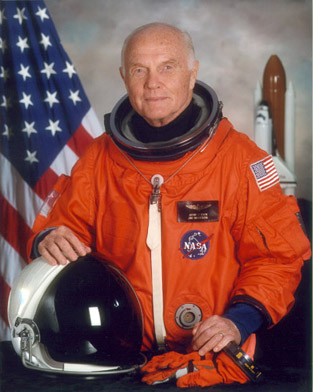John Herschel Glenn,
Jr.

John Glenn
Credits - NASA
John H. Glenn was born July 18, 1921 in Cambridge, Ohio. He
attended schools in New Concord, Ohio, and Muskingum College in New Concord,
receiving a Bachelor of Science degree in Engineering. Muskingum College also
awarded him an honorary Doctor of Science degree in engineering. He has
received honorary doctoral degrees from nine colleges or universities.
Glenn has received numerous awards including the
Distinguished Flying Cross on six occasions, the Air Medal with 18 Clusters for
his service during World War II and Korea, the Navy Unit Commendation for
service in Korea, the Asiatic-Pacific Campaign Medal, the American Campaign
Medal, the World War II Victory Medal, the China Service Medal, the National
Defense Service Medal, the Korean Service Medal, the United Nations Service
Medal, the Korean Presidential Unit Citation, the Navy's Astronaut Wings, the
Marine Corps' Astronaut Medal, the NASA Distinguished Service Medal, and the
Congressional Space Medal of Honor.
Glenn entered the Naval Aviation Cadet Program in March 1942
and was graduated and commissioned in the Marine Corps in 1943. After advanced
training, he joined Marine Fighter Squadron 155 and spent a year flying F-4U
fighters in the Marshall Islands.
During World War II, he flew 59 combat missions. After the
war, he was a member of Marine Fighter Squadron 218 on the North China patrol
and served on Guam. From June 1948 to December 1950, Glenn taught advanced
flight training in Texas and then attended Amphibious Warfare Training at
Quantico, Virginia. In Korea he flew 90 missions with the Marines and the Air
Force. In the last nine days of fighting in Korea, Glenn downed three MIGs
along the Yalu River.
In July 1957, he set a transcontinental speed record from
Los Angeles to New York, spanning the country in 3 hours and 23 minutes. This
was the first transcontinental flight to average supersonic speed. Glenn has
nearly 9,000 hours of flying time, with approximately 3,000 hours in jet
aircraft.
Glenn was assigned to the NASA Space Task Group in April
1959, after his selection as a Project Mercury astronaut. On February 20, 1962,
Glenn piloted the Mercury-Atlas 6 Friendship 7 spacecraft on the first
piloted orbital mission of the United States. He completed three-orbits around
the Earth, reaching a maximum altitude of approximately 162 statute miles and
an orbital velocity of approximately 17,500 miles per hour.
Glenn resigned from NASA's Manned Spacecraft Center (later
renamed Johnson Space Center) in January 1964. He was promoted to the rank of
Colonel in October 1964 and retired from the Marine Corps on January 1, 1965.
Glenn worked in business from 1965 until his election to the U.S. Senate in
November 1974, where he served until his retirement in January 1999.
From October 29 to November 7, 1998, Glenn flew as a payload
specialist on STS-95 Discovery. The mission traveled 3.6 million miles in 213
hours and 44 minutes, circling the Earth 134 times.
In total, Glenn has logged more than 218 hours in space.



